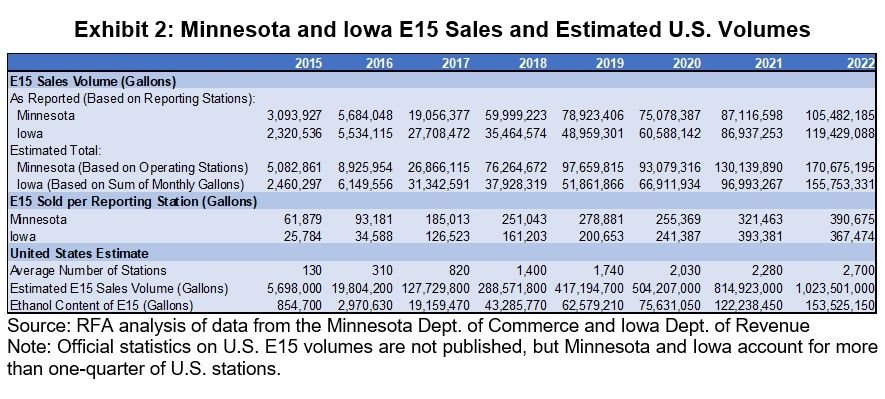By Scott Richman, Chief Economist
U.S. sales of E15, a blend of 15% ethanol and 85% gasoline, are estimated to have hit a record 1.02 billion gallons in 2022, based on a Renewable Fuels Association analysis of data recently released by state agencies in Minnesota and Iowa. Sales increased by 26% from 2021 (Exhibit 1), bolstered by compelling economics as U.S. gasoline prices reached record highs in the aftermath of the Russian invasion of Ukraine. On average, E15 was $0.20-0.30/gallon less expensive than regular unleaded gasoline (E10) at retail stations last summer.
In 2022, E15 sales by stations that reported their volumes were over 100 million gallons (mg) in both Iowa and Minnesota for the first time (Exhibit 2). However, based on supplemental information from the Minnesota Dept. of Commerce and the Iowa Dept. of Revenue, it can be estimated that actual E15 volumes were 171 mg in Minnesota and 156 mg in Iowa, including stations that sold E15 but did not report their volumes. U.S. sales are based on the average estimated volume per station in the two states, multiplied by the RFA’s count of the number of stations selling E15 nationwide.
Click on image for larger size
Sales last summer were facilitated not only by favorable pricing but also by the Biden administration’s granting of a series of waivers for E15 from an obsolete fuel requirement. Whereas many retailers had previously found it difficult or impossible to offer E15 during the summer months in conventional gasoline areas, in 2019 the Environmental Protection Agency issued a regulation allowing E15 to be sold year-round.[1] However, in 2021 the D.C. Circuit Court of Appeals vacated the regulation, ruling in favor of oil refiners who argued that EPA had exceeded its authority, although the decision did not affect E15 sales that summer.
The restriction would have returned last year, but EPA invoked its authority to issue emergency waivers when “extreme and unusual fuel or fuel additive supply circumstances exist,” which was the case due to the combination of product import bans, economic sanctions, and price volatility that ensued after Ukraine was invaded. An analysis by the RFA found that the availability of additional E15 volumes saved American consumers approximately $60 million last summer. More broadly, the overall usage of ethanol reduced the price paid by U.S. drivers for gasoline by an average of $0.77/gallon between 2019 and 2022, according to a recent study conducted by energy economists from the University of California-Berkeley and the Czech Republic.
However, if the administration does not take action within the next month, E15 sales will drop precipitously in most of the country this summer, as was the pattern in conventional gasoline areas prior to 2019. The governors of eight Midwest states petitioned the EPA last year to allow them to opt out of more-lenient fuel volatility specifications that apply to E10 than to E15, but the agency delayed its response far beyond the statutory deadline and now has proposed to grant the request but defer implementation to 2024. The only practical solution in the near term is for waivers to be issued nationally again this summer.
If anything, the case for such action is even stronger this year. According to the Energy Information Administration, total U.S. inventories of crude oil and petroleum products are 6% below this time last year and are at a 19-year low seasonally. The Strategic Petroleum Reserve is at its lowest level in 40 years, rendering it difficult to use to balance supplies as was done last year. More specifically, gasoline inventories are below year-ago levels and are at a 9-year low seasonally.
E15 is available to extend gasoline supplies at a competitive price, and unlike the case with supplemental supplies of crude oil it is not constrained by refinery capacity since ethanol is blended into gasoline at the fuel distribution terminal. The ability to ramp up E15 volumes was demonstrated once again last year, and the Biden administration should take immediate action to allow E15 to continue to be sold in conventional gasoline areas this summer, just as has been the case the last four years. Doing so would benefit American consumers, energy security, and the environment.
[1] EPA limits the volatility of gasoline during the “high ozone season” every summer (Jun. 1-Sep. 15). Prior to EPA’s 2019 rule change, the practical volatility limit for E10 sold in conventional gasoline areas was 10 pounds per square inch (psi) Reid vapor pressure (RVP), but E15 was held to a 9-psi limit. EPA’s 2019 rule effectively extended the volatility limit for E15 to 10 psi, creating regulatory parity for E15 and E10.



